Labels for Safety, Visuals and Facility ID Desktop Printers
Labels for Product, Wire and Lab ID Benchtop Printers
Labels for Safety, Visuals and Facility ID Desktop Printers
Labels for Product, Wire and Lab ID Benchtop Printers
Safety and Facility ID Desktop Printers
Product, Wire and Lab ID Benchtop Printers
Barcode Scanner and Printer Kits
Barcode Scanner and Printer Kits
PaintStripe Floor Marking Stencils
Valve Lockouts & Hose Lockouts
Group Lock Boxes & Permit Control
Brady Safety Lockout Tagout Services
Pipe Marker Accessories & Mounting Brackets
Maintenance and Production Tags
Calculators and Assessment Tools
Product Finders and Data Sheets
This comprehensive article takes a look at the 10 most common lockout tagout (LOTO) violations, emphasizing the necessity of precise and compliant practices, particularly in environments with hazardous machinery. Readers will learn about the crucial aspects of compliance, common pitfalls and their consequences. Real-life examples are provided to underline the serious nature of these violations, along with key strategies for ensuring workplace safety and adherence to Occupational Safety and Health Administration (OSHA) standards.
At the core of effective workplace safety lies the essential requirement of having precise lockout tagout (LOTO) procedures. Compliance with 29 CFR 1910.147 is not just a regulatory mandate; it's a crucial safeguard against workplace accidents. This standard explicitly necessitates the development and upkeep of specific, detailed procedures tailored to each piece of equipment. Its primary objective is to prevent the inadvertent startup or uncontrolled release of stored energy from machines – situations that can lead to severe consequences.
One of the most significant lapses in adhering to a lockout tagout system is the tendency to overlook the unique needs of each piece of equipment. This oversight typically manifests in the use of generic or outdated procedures, failing to address the specific hazards and control requirements of individual machines. The danger here lies not just in non-compliance, but in the very real risk of inadequate safety measures when dealing with complex or specialized equipment.
Incomplete or missing lockout tagout procedures dramatically escalate the risk of workplace accidents. OSHA is vigilant in enforcing these standards, often resulting in hefty fines and legal liabilities for offending organizations. Beyond financial penalties, the more distressing consequence is the potential harm to employees, ranging from minor injuries to fatal accidents.
A vivid illustration of the dangers inherent in neglecting lockout tagout procedures is evident in a 2023 case involving an Ohio meat processing facility, subjected to $278,000 in OSHA fines (source: EHS Daily Advisor). This substantial fine was imposed in the wake of a grave incident in which an employee suffered severe injuries after accidentally falling into a vat containing corrosive chemicals. Upon investigation, it was discovered that the company had not adequately implemented the necessary lockout tagout procedures. This lapse played a significant role in causing the accident.
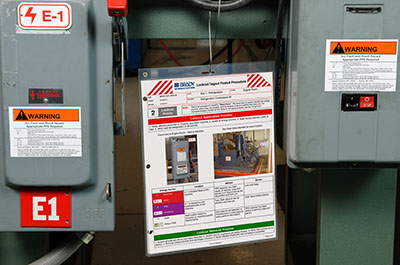
A cornerstone of effective workplace safety, especially in areas where lockout tagout is essential, is the thorough training of employees. Although 29 CFR 1910.332 isn't solely focused on lockout tagout, it underscores the importance of safety-related work practices, which include comprehensive lockout tagout training.
A prevalent issue in many lockout tagout programs is insufficient employee training. This deficiency often presents itself as inadequate initial training sessions or a failure to provide updated training when lockout tagout procedures are modified. The lack of depth and frequency in lockout tagout training sessions leads to a workforce that is ill-prepared to handle the specific requirements and potential dangers of lockout tagout systems. This shortfall is not merely a matter of ticking compliance boxes; it directly impacts the efficacy of the entire safety protocol.
The consequences of inadequate training extend well beyond failing to meet regulatory standards. Insufficiently trained employees are a significant liability, leading to unsafe practices and potential accidents. The Occupational Safety and Health Administration (OSHA) actively enforces training requirements, and non-compliance can result in substantial penalties. However, beyond the financial repercussions, the more significant risk is the possibility of endangering employee lives, turning preventable incidents into real tragedies.
An example of a lockout tagout training failure leading to an OSHA violation involved a Texas-based furniture manufacturer. The company faced significant fines for repeated violations in hazardous energy control and failing to comply with lockout tagout procedures, following an incident where an employee was injured. This case highlights the critical need for specific procedures and proper employee training in lockout tagout practices. (Source: OSHA)
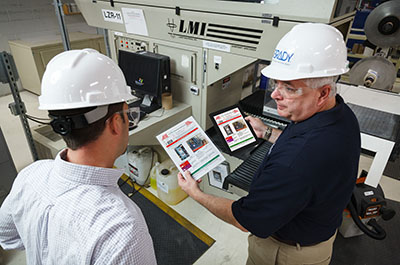
Essential to lockout tagout safety is clear, consistent communication, underscored by 29 CFR 1910.145. This regulation mandates the use of proper signs, tags and labels for accident prevention, crucial for conveying lockout tagout procedures effectively.
In many instances, lockout tagout systems falter due to inconsistent tagging systems and poor communication about the status of lockout tagout procedures. Inadequate or unclear communication can lead to misunderstandings about which equipment is safe to operate, creating hazardous work environments.
The implications of these communication shortcomings are serious, leading to unsafe conditions and heightened accident risks. Miscommunication can result in employees inadvertently working on machines that are not safely de-energized, posing significant dangers.
Imagine a scenario in a manufacturing plant where a routine lockout tagout procedure is underway. The maintenance team applies locks but fails to communicate this effectively to the rest of the staff through signs or lockout devices. Consequently, an operator, unaware of the maintenance work, attempts to start a machine, leading to a near-miss incident. This situation illustrates the crucial need for robust communication strategies in lockout tagout practices to ensure the safety of all employees and prevent potential accidents.

Compliance with 29 CFR 1910.333 requires the identification and documentation of all energy sources for each piece of equipment. This is essential for safely de-energizing equipment and working around live parts.
Often, the complexity of identifying all energy sources in a lockout tagout system is underestimated. It's not just about electrical and mechanical energies; overlooked sources often include hydraulic, pneumatic, chemical, and even gravitational energies. For example, failure to recognize potential energy stored in elevated machine parts or pressurized systems is common. Additionally, overlooking energy stored in capacitors or in the form of residual heat can be a critical error.
Not identifying all energy sources can result in unintended energization, causing serious injuries or fatalities.
Consider a hypothetical situation in a chemical plant where residual thermal energy in a system was not identified. During maintenance, a worker believed the system was fully de-energized but suffered severe burns due to the overlooked thermal energy. This incident highlights the critical need for comprehensive energy source identification in lockout tagout procedures.

Compliance with 29 CFR 1910.147(c)(6) mandates regular inspections and reviews of lockout tagout procedures and practices. These periodic checks are essential to ensure that energy control procedures are being correctly followed and are up to standard.
Many workplaces neglect these crucial inspections, while others fail to take action on issues identified during the review. This negligence can lead to outdated or ineffective LOTO procedures being used. Implementing comprehensive lockout tagout kits can be an effective way to ensure all necessary and up-to-date tools are readily available, supporting consistent and effective safety practices.
Failing to conduct regular inspections can degrade overall safety practices. It can lead to unnoticed procedural flaws, increasing the risk of accidents and compromising worker safety. This neglect can result in preventable accidents, causing injuries and potentially severe legal and financial consequences for the organization.
Consider a scenario in an industrial facility where regular LOTO inspections were overlooked. As a result, a piece of equipment that hadn't been inspected for over a year malfunctioned, causing a severe injury to a technician. This incident could have been prevented with proper and timely inspections, emphasizing their importance in a LOTO program.

Compliance with 29 CFR 1910.147(e) details that only the person who applied a lock or tag on equipment for lockout tagout should remove it. This is crucial for controlling the re-energization of machines or equipment.
Unauthorized removal of lockout tagout locks or tags is often a result of miscommunication, misunderstanding of procedures, or urgency to resume operations. Employees may bypass protocols due to time constraints or lack of awareness of the ongoing maintenance or repair work. This disregard for procedures is sometimes seen in high-turnover environments where consistent training and reinforcement of safety standards are challenging.
Removing locks or tags without proper clearance can lead to the premature re-energization of equipment. This mistake can cause accidents, including electrocution, crushing, or amputation, significantly endangering workers' lives. Additionally, such violations attract legal and regulatory consequences, including OSHA citations, which can lead to fines and heightened scrutiny on the organization's safety practices. These incidents also reflect poorly on the company’s commitment to safety and can affect its reputation and employee morale.
Imagine a situation where an unauthorized employee removed a lockout device thinking the maintenance was complete. This led to the accidental startup of the equipment, resulting in serious injury. Such incidents demonstrate the dangers of disregarding proper lock and tag removal procedures.
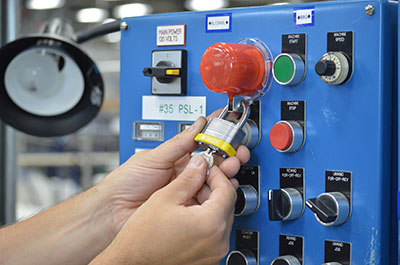
According to 29 CFR 1910.147(d), it's essential to use proper, durable locks and tags in lockout tagout procedures to maintain a zero-energy state in equipment.
The use of substandard locks or tags and incorrect application are common errors. This might include using non-durable materials, failing to secure locks adequately, or incorrectly tagging out equipment, which could lead to confusion or misidentification.
Improper use of locks and tags can result in ineffective lockout, leaving equipment potentially energized. This increases the risk of accidental startup, which can lead to dangerous incidents, potentially causing injuries or fatalities. Additionally, these lapses in following standard procedures can lead to regulatory penalties.
Envision a workplace where an employee used a non-durable tag for a high-temperature machine. The tag deteriorated quickly, leading to confusion about the machine's status and an inadvertent restart while maintenance was still ongoing. This resulted in a severe injury, illustrating the dangers of using substandard lockout tagout equipment.
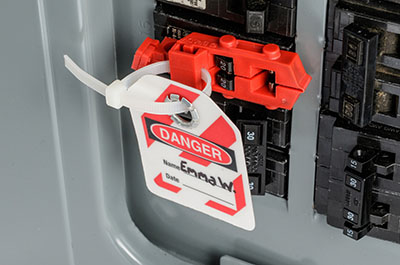
According to 29 CFR 1910.147(f), effective group lockout tagout procedures are essential for collaborative work. This section guides the implementation of LOTO in group maintenance and servicing activities.
Groups often fail to use individual lockout devices for each member, leading to poor coordination. This oversight can create uncertainty about who is responsible for the lockout at any given time.
Inadequate group LOTO procedures can cause confusion and increase the risk of premature equipment re-energization, leading to potential injuries.
Imagine a team working on a large machine. Due to insufficient group LOTO procedures, only one lockout device was used for the entire team, causing confusion over the machine's operational status. The machine was inadvertently re-energized, causing an injury to one of the workers. This incident underlines the importance of effective group LOTO procedures.
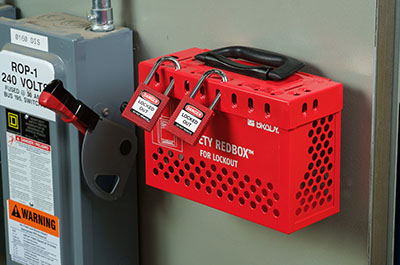
Coordination of LOTO procedures with contractors is mandated by 29 CFR 1910.147(b). This regulation specifies the integration of contractors into LOTO procedures, emphasizing their roles and responsibilities.
Not informing contractors about specific lockout tagout procedures is a common error, often due to communication gaps or assumptions that contractors are already familiar with the protocols, leading to potentially unsafe conditions. To address this, having accessible lockout tagout stations can be crucial. These stations can serve as central points for sharing information and ensuring that all parties, including contractors, have easy access to necessary lockout tagout tools and procedures, thus enhancing overall safety and understanding.
Not adequately communicating LOTO procedures to contractors can lead to miscommunication and unsafe practices. This increases the risk of accidents involving contractors, which can have severe implications for both the contractors and the hosting organization.
Consider a situation where a contractor was not briefed on a company's LOTO procedures and ended up starting a machine that was under maintenance. This led to a near-miss incident, highlighting the importance of clearly communicating LOTO procedures to all involved parties, including contractors.

Regular updates to lockout tagout procedures are required as per 29 CFR 1910.147(c)(4), particularly when there are changes in equipment or processes. This ensures that written energy control procedures remain effective and compliant.
A frequent issue is neglecting to update LOTO procedures following changes in equipment or operational processes. This oversight can lead to reliance on outdated methods, compromising safety.
Failure to update LOTO procedures can result in the use of outdated practices, elevating the risk of accidents and non-compliance. This oversight can have serious implications for worker safety and regulatory adherence.
Consider a manufacturing facility that failed to update its LOTO procedures after installing new equipment. The existing procedures were inadequate for the new machinery, leading to a serious accident. This case highlights the critical need for keeping LOTO procedures current with any operational changes.

This article's exploration of lockout tagout violations sheds light on the necessity of strict safety protocols in the workplace. Through understanding these violations, their consequences and best practices for compliance, organizations can significantly reduce risks.
Brady is committed to aiding organizations in steering clear of LOTO violations. Our approach centers on offering advanced solutions tailored to prevent these common safety missteps. By leveraging our specialized expertise and innovative product range, we provide tools and strategies that are essential for maintaining high safety standards and ensuring LOTO compliance in diverse work environments.
Contact us
Discover key lockout tagout compliance errors and learn how to prevent them. This guide offers insights into avoiding common LOTO violations.
Explore lockout tagout tryout
Explore essential steps for standardizing your LOTO program in this informative article. It focuses on creating an effective and compliant safety strategy.
Discover the 6 steps in a lockout program
Learn about the differences between keyed different and keyed alike lockout tagout systems. Understand which option is best for your safety needs.
Explore keyed different vs keyed alike